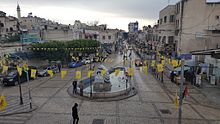Tulkarm Governorate
During the Ottoman period, the region later forming the Tulkarm Governorate belonged to Jabal Nablus.
With the help of rural trading partners, these urban notables established trading monopolies that transformed Jabal Nablus’ autarkic economy into an export-driven market, shipping vast quantities of cash crops and finished goods to off-shore markets.
Increasing demand for these commodities in the Ottoman Empire’s urban centers and in Europe spurred demographic growth and settlement expansion in the lowlands surrounding Jabal Nablus.
[4][5] In the 1860s, as part of the Ottoman Tanzimat, the area of Wadi al-Sha‘ir (Nahal Shechem) was incorporated into the Bani Ṣa‘b nahiya.
Then, in the 1870s and 1880s, Bani Ṣa‘b was elevated into the level of a subdistrict with its qa’imaqam and municipal council administrated from Tulkarm.
